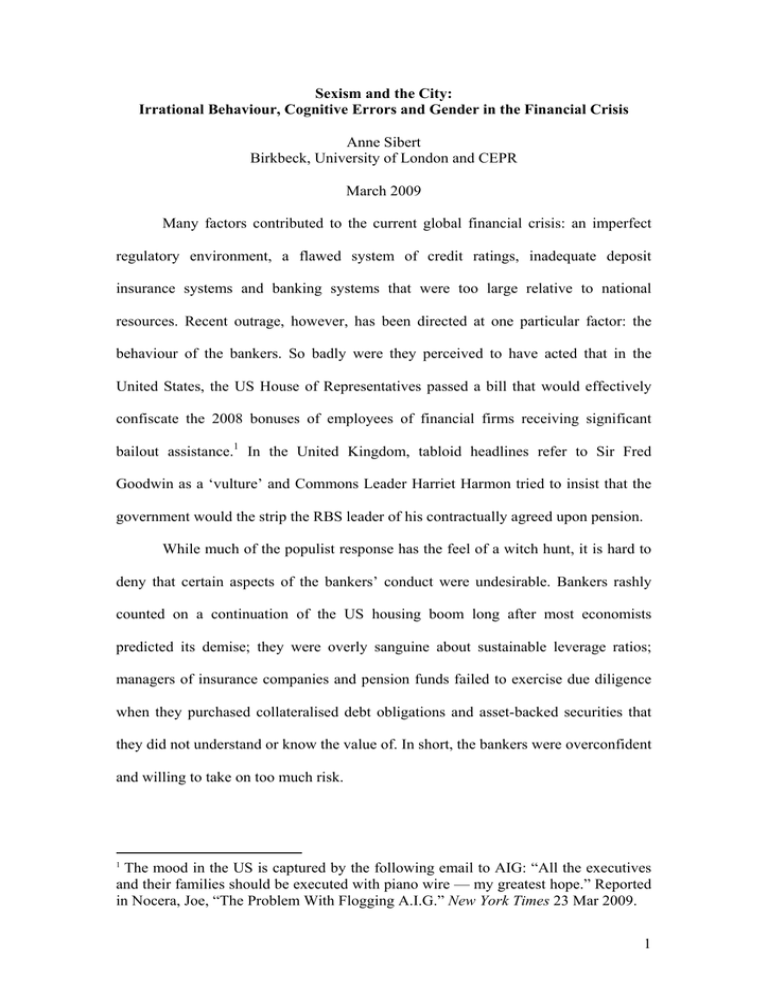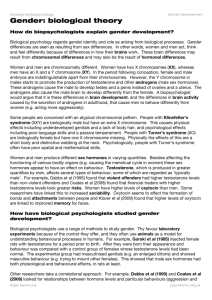Anne Sibert Birkbeck, University of London and CEPR March 2009
advertisement

Sexism and the City: Irrational Behaviour, Cognitive Errors and Gender in the Financial Crisis Anne Sibert Birkbeck, University of London and CEPR March 2009 Many factors contributed to the current global financial crisis: an imperfect regulatory environment, a flawed system of credit ratings, inadequate deposit insurance systems and banking systems that were too large relative to national resources. Recent outrage, however, has been directed at one particular factor: the behaviour of the bankers. So badly were they perceived to have acted that in the United States, the US House of Representatives passed a bill that would effectively confiscate the 2008 bonuses of employees of financial firms receiving significant bailout assistance.1 In the United Kingdom, tabloid headlines refer to Sir Fred Goodwin as a ‘vulture’ and Commons Leader Harriet Harmon tried to insist that the government would the strip the RBS leader of his contractually agreed upon pension. While much of the populist response has the feel of a witch hunt, it is hard to deny that certain aspects of the bankers’ conduct were undesirable. Bankers rashly counted on a continuation of the US housing boom long after most economists predicted its demise; they were overly sanguine about sustainable leverage ratios; managers of insurance companies and pension funds failed to exercise due diligence when they purchased collateralised debt obligations and asset-backed securities that they did not understand or know the value of. In short, the bankers were overconfident and willing to take on too much risk. 1 The mood in the US is captured by the following email to AIG: “All the executives and their families should be executed with piano wire — my greatest hope.” Reported in Nocera, Joe, “The Problem With Flogging A.I.G.” New York Times 23 Mar 2009. 1 It has been argued that some of this objectionable behaviour was a rational reaction to a flawed compensation structure that rewarded perceived short-term competency, rather than good long run results – see, for example, Sabourian and Sibert (2009). However, the misconduct was so pervasive that much of it must have been genuinely due to irrationality and cognitive errors. A striking feature of the financial services industry is the extent to which it is male denominated. Women hold 17 percent of the corporate directorships and 2.5 percent of the CEO positions in the finance and insurance industries in the United States.2 In Iceland – home to a particularly spectacular collapse – it is said that there was just one senior woman banker, and she quit in 2006. 3 As senior City of London official Stuart Fraser colourfully put it, “There are quite a lot of alpha males with testosterone steaming out their ears." This has led some to wonder whether this male dominance contributed in any way to the financial crisis. UK Labour cabinet member Hazel Blears, for example, conjectures, “Maybe if we had some more women in the boardrooms, we may not have seen as much risk-taking behaviour.”4 Would things have been different if the banks had been run by mistresses of the universe? To the end of answering this perhaps rather politically incorrect question, I have picked what I consider to be the two most important aspects of bad behaviour displayed by the bankers: excessive risk taking and overconfidence and I consider what the economics and psychology literature has to say about gender differences – due to either nature or nurture – in this regard. There is a substantial economics literature on the effect of gender on attitudes toward risk and most of it appears to support the idea that men are less risk averse 2 See Sullivan and Jordan (2009). See Lewis, Michael, “Wall Street on Tundra,” Vanity Fair, Apr. 2009. 4 Fraser and Blears are quoted in Sullivan and Jordan (2009). 3 2 than women.5 Jianakoplas and Bernasek (1998) and Bernasek and Shwiff (2001) look at holdings of financial assets to document that women are significantly more risk averse about financial decisions than are men. In experiments using American undergraduates, MBAs and business school faculty, Holt and Laury (2002) find that men are somewhat less risk averse than women; in experiments using American undergraduates, Eckel and Grossman (2002) find substantial evidence that men are less risk averse with regard to financial risk than are women. Hersch (1996) documents that women also exhibit safer behaviour than men with respect to smoking, seat belt use, preventative dental care, exercise and checking their blood pressure.6 There is a sizable literature documenting that men are more confident of their abilities at activities that are perceived as traditionally male. Using data on 35,000 households from a large brokerage firm, Barber and Odean (2001) argue that men are substantially more overconfident than women in financial markets. Overconfidence is not related to ability: it is found even when women perform as well or better than men. Using undergraduate and graduate students, Lundeberg et al (1994) found that most students were over confident, but women were less overconfident then men, “who tended to show high degrees of confidence when wrong.” (p. 115) It also appears that success is more likely to increase overconfidence in men than in women. Campbell and Sedikides (1999) document the importance of the selfserving bias: a tendency to attribute success to one’s own ability and failure to external factors. Beyer (1990) and others, however, find that this effect is stronger in 5 Social psychologists appear to be less interested in the topic. Not all studies find gender differences. Schubert et al (1999) found no evidence of a gender effect in experiments using Swiss undergraduates. Booth and Nolen (2009) use experimental evidence to argue that gender differences in behaviour under uncertainty might reflect differences in nurturing. 6 3 men than in women. Thus, if confidence helps produce successful outcomes, there is more likely to be strong feedback loop in confidence in men than in women. In a fascinating and innovative study, Coates and Herbert (2008) consider the effect of testosterone on both risk aversion and overconfidence. They explain that testosterone – a steroid hormone -- rises in athletes preparing for a contest; it rises further in winners and falls in losers. Because increased testosterone increases confidence and risk taking, this produces a positive feedback loop in the winners as it improves their chances of winning again. They hypothesised that something similar might happen in financial market participants. To test this, they took samples of testosterone levels of 17 male traders on a typical London trading floor (which had 260 traders, only four of whom were female) twice a day for eight days. (They controlled for food, medications and whether the traders had received any important news from outside work.) They found that testosterone was significantly higher on days when traders made more than their daily one-month average profit. Furthermore, higher levels of testosterone led to greater profitability – presumably because of greater confidence and risk taking. The authors hypothesise that if raised testosterone were to persist for several weeks the elevated appetite for risk taking might have important behavioural consequences and there might be cognitive implications as well. Testosterone, they say, has receptors throughout the areas of the brain that neuroeconomic research has identified as contributing to irrational financial decisions. They also point to a study where testosterone was administered to a group of subjects playing a gambling task and it led to irrational behaviour: subjects preferred options with high variance and a negative expected return to options with a low variance and a positive expected 4 return. They speculate that steroid feedback loops may help explain why bankers behave irrationally when caught up in bubbles. In light of recent events, studies showing gender differences between men and women with regard to risk taking and overconfidence may appear to cast men in a bad light: perhaps men are too risk loving and overconfident. But, interestingly, most of the studies written before the crises viewed the difference as a problem for women. The authors suggested that too much risk aversion and too little self confidence caused women to make bad financial decisions and to be kept out of top jobs. If men are, say, too risk loving and women are too risk averse, this suggests that a work group composed primarily of men or primarily of women may be a particularly bad idea. Over 300 studies in the social psychology literature document the phenomenon that group deliberation tends to result in an average opinion that is more extreme than the average original position of group members. If a group is composed of overly cautious individuals, it will be even more cautious than its average member; if it is composed of individuals who are overly tolerant of risk, it will be even less risk averse than its average member.7 Thus, a more even balance of men and women in the financial services industry might have produced better a better result.8 Unfortunately, the current climate in the financial services industry is generally described as hostile toward women. Women in UK banks, for example, are paid on average 40 per cent less than men, compared with about 23 percent less in the workforce as a whole. There is evidence that lap dancing is considered appropriate 7 See Buchanan and Huczynski (1997) for a discussion of this. There exists a literature examining the effect of gender on group performance, but it does not consider tasks involving risk. Some authors find that diversity increases conflict, but recent papers by Fenwick and Neal (2001), Hansen et al (2006) and Orlitzky and Benjamin (2003) find that mixed-gender groups outperform singlegender groups. 8 5 corporate entertainment.9 It is difficult to say whether the preponderance of men led to this unfortunate culture or vice versa, but given the evidence described, a manager interested in good long-term performance might want to think about making the climate more favourable to women and increasing the number hired. References Barber, Brad M. and Terrance Odean, “Boys will be Boys: Gender, Overconfidence and Common Stock Investment,” Quarterly Journal of Economics 66, 2001, 261-292. Bernasek, Alexandra and Stephanie Shwiff, “Gender, Risk and Retirement,” Journal of Economic Issues 35, 2001, 345-356. Beyer, Sylvia, “Gender Differences in the Accuracy of Self-Evaluations of Performance,” Journal of Personality and Social Psychology, 59, 1990, 960970. Booth, Allison L. and Patrick Nolan, “Gender Differences in Risk Behaviour: Does Nurture Matter,” CEPR Discussion Paper 7198, March 2009. Buchanan, David and Andrzej Huczynski, Organizational Behaviour, London, Prentice-Hall, 1997. Campbell, W. Keith and Constantine Sedikides, “Self-Threat Magnifies the SelfServing Bias: A Meta-Analytic Integration,” Review of General Psychology 3, 1999, 23-43. Coates, J. M. and J. Herbert, “Endogenous Steroids and Financial Risk Taking on a London Trading Floor,” Proceedings of the National Academy of Sciences 105, 2008, 6167-6172. Eckel, Catherine C. and Philip J. Grossman, “Sex Differences and Statistical Stereotyping in Attitudes toward Financial Risk,” Evolution and Human Behaviour 23, 2002, 281-295. Fenwick, Graham D. and Derrick J. Neal, “Effect of Gender Composition on Group Performance,” Gender, Work and Organization 8, 2001, 205-225. Hansen, Zeynap, Hideo Owan and Jie Pan, “The Impact of Group Diversity and Team Governance Structure on Performance – Evidence from College Classroom,” NBER Working Paper 12251, 2006. 9 UK Equality and Human Rights Commission. 6 Hersch, Joni, “Smoking, Seat Belts and other Risky Consumer Decisions: Differences by Gender and Race,” Managerial and Decision Economics 5, 1996, 471-481. Holt, Charles A. and Susan K. Laury, “Risk Aversion and Incentive Effects,” American Economic Review 92, 2002, 1644-1655. Jianakoplas, Nancy A. and Alexandra Bernasek, “Are Women more Risk Averse?” Economic Inquiry 36, 1998, 620-630. Lundeberg, Mary A., Paul W. Fox and Judith Punccohar, “Highly Confident but Wrong: Gender Differences and Similarities in Confidence Judgements,” Journal of Educational Psychology 86, 1994, 114-121. Orlitzky, Marc and John D. Benjamin, “The Effects of Sex Composition on SmallGroup Performance in a Business School Case Composition,” Academy of Management Learning and Education 2, 2003, 128-138. Sabourian, Hamid and Anne Sibert, “Banker Compensation and Confirmation Bias,” CEPR Working Paper no. 7263, Apr. 2008. Schubert, Renate, Martin Brown, Matthias Gyster and Hans Wolfgang Brachinger, “Financial Decision Making: Are Women Really more Risk Averse?” American Economic Review 89, 1999, 381-385. Sullivan, Kevin and Mary Jordan, “In Banking Crisis, Buys get the Blame: More Women Needed in Top Jobs, Critics Say,” Washington Post Foreign Service, 11 Feb. 2009. 7



